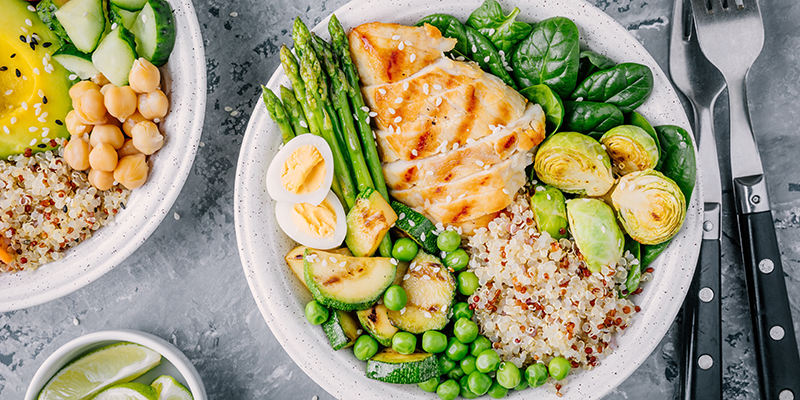We don’t know about you, but around here, we tend to be healthily skeptical about diet- and fitness-related buzz words, since what starts as a genuine health concern can devolve pretty quickly into marketing ploys. Included in our tread-thoughtfully approach is the hugely popular “gluten-free.”
You May Also Like: Keto What?? How Does a High-Fat Diet Help You Lose Weight?
Gluten-Free Is Actually Healthy—Sometimes.
Here’s the thing: minimizing your gluten intake really can be good for your health (even if you’re not someone who has a legit gluten allergy like Celiac disease). Research shows that gluten (a protein found in grains such as wheat, barley, and rye) can lead to a variety of negative effects on the body, including gut inflammation, impaired nutrient absorption, gastrointestinal upset, and a disruption to the “healthy” bacteria living in your intestinal tract. The kicker? Food manufacturers have even developed the practice of sneaking gluten into a variety of foods including deli meat, candy bars, soups, and salad dressings.
Of course, given that these deleterious effects of gluten really do exist, you may wonder why we’re reluctant to wholeheartedly embrace products labeled as gluten-free.
A word to the wise: just because some packaged or processed food or at-home recipe is advertised as “gluten-free” does not necessarily mean it’s healthy for you! After all, gluten-free products can still contain high amounts of sodium, sugar, calories, and other unpleasant additives and ingredients.
And while they may be well-intentioned, food companies are surely well-aware of the growing popularity gluten-free as a lifestyle choice, and seem to be pumping out new products accordingly: hence the grocery store shelves filled with gluten-free crackers, pasta, bread, candy bars, etc.
(Of course, asparagus, free-range chicken, wild blueberries are naturally gluten-free, but you never really hear those being advertised as such, do you?)
So no, just because you made a plate of gluten-free brownies doesn’t mean it’s wise to chow down half of them. Instead, we recommend being mindful of the following in order to stay healthy in a gluten-obsessed world:

Focus on maintaining a balanced diet.
Master the basics of a clean and well-rounded diet: lean animal protein, tons of healthy fat, veggies and fruit, and lots and lots of water. Make this your focus instead of looking for the next G-free product (or avoiding gluten at all costs). You’ll be much better off.
Feel free to enjoy gluten-free treats…in moderation.
By cutting out or cutting down on gluten from your diet, you may realize that you do actually feel better without it, which is awesome. If this is the case, feel free to experiment with gluten-free options, but remember that they aren’t consequence-free if consumed to excess, and almost never the better option compared to real unprocessed food.
Explore and investigate your relationship with food in general.
If you’re craving cookies or sweets or bread or pasta—whether they’re gluten-free or not—try asking yourself: why? What types of food do you tend to gravitate toward when you’re mindlessly eating vs. when you’re mindfully eating? If we learn to think about our food more often as fuel rather than crutches or comfort, then we gain not only physical health but psychological health, too.


